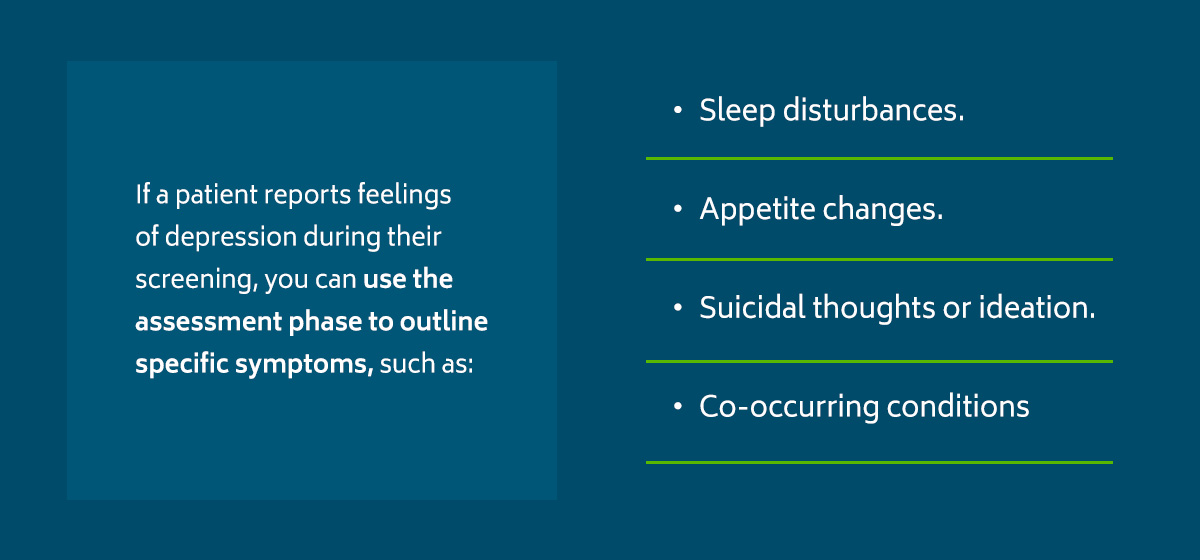 mental health treatment plan is to help a patient achieve their goals." width="1200" height="560" />
mental health treatment plan is to help a patient achieve their goals." width="1200" height="560" />A mental health treatment plan is a document that contains specific details relating to an individual patient and their treatment. Treatment plans are an effective tool for improving patient engagement in their treatment because they outline their current struggles and how they will overcome them with a therapist's help. While treatment plans vary depending on a patient's needs, they typically follow the same general format, which includes:
 mental health treatment plan is to help a patient achieve their goals." width="1200" height="560" />
mental health treatment plan is to help a patient achieve their goals." width="1200" height="560" />
A mental health treatment plan, sometimes called a therapy or psychotherapy treatment plan, aims to help patients achieve their goals by relieving symptoms and helping them overcome the challenges they're experiencing in their initial treatment session. Treatment plans also help behavioral health professionals, like counselors, monitor a patient's progress and determine if treatment adjustments are necessary.
Without a treatment plan, it may be difficult for patients to visualize the path they need to take to reduce their negative thinking patterns or improve their habitual behaviors. Lacking this structure can make it more difficult for patients to set and accomplish their therapy goals. Goal-setting is a significant treatment plan component that contributes to the effectiveness of a mental health intervention. Setting goals in a treatment plan helps patients:
Treatment plans also help therapists and behavioral health clinicians with documentation. Treatment plans contain essential information about a patient's progress in a clear and organized format, with measurable goals and target completion dates. With this information readily available, documenting progress toward goals in each individual session note becomes an easier part of the job.
Write Better Treatment Plans - Free Guide
 treatment plan guide" width="1000" height="1000" />
treatment plan guide" width="1000" height="1000" />
Download this free guide to learn everything you need to know to write better treatment plans
Using a treatment plan is an effective way for therapists to engage patients in their treatment and allow them to work together to create goals and objectives that align with their shared vision. Treatment plan goals can include general purposes and intentions the patient wishes to accomplish.
Goals tend to be broad statements the patient wants to achieve by the end of their treatment.
Consider these examples:
Think of an objective as a rung on a ladder that gets the patient closer to their goals. Objectives tend to be smaller, specific tasks or skills a patient must accomplish to reach their larger treatment goals. These tasks should be clear and measurable, giving the patient direction toward their goals. For example, you may record objectives like:
Simply said, an objective is a specific way to reach a goal.
Every patient has different needs, so their goals and objectives in therapy will vary. If your patient is committed to change but doesn't know where to start, they can set a few goals they want to achieve throughout their therapy treatment.
A few goals to consider during mental health treatment include:
Once these goals are set, you and your patient can work on specific actions — or objectives — that can back up these overarching goals.
For instance, if a patient has extreme anxiety when leaving the house, they could set a goal of walking 30 steps outside their front door. Eventually, they can work up to going to the grocery store or practicing daily walks around the neighborhood. If your patient has difficulty interacting with others in a social setting, they may set a goal of talking to one new person each week or joining a club to practice conversing with others regularly.

Before creating a treatment plan, the first step is to gather information in a screening. The second step is to conduct a mental health assessment. During the screening of a new client, they should provide you with a brief overview of the presenting issue or issues that motivated them to seek therapy. Once you have a general understanding of their condition and needs, you can move on to the assessment step.
During the assessment stage, you'll gain a more detailed view of the nature and severity of your patient's presenting problem. For example, if a patient reports feelings of depression during their screening, you can use the assessment phase to outline specific symptoms, such as:

After a detailed assessment and discussion with your client, you'll be ready to draft a treatment plan tailored to their specific needs. At this time, you'll also need to identify and discuss possible goals with your client. Consider this last step a collaborative process — ensure that the goals outlined in the treatment plan are agreeable and realistic.
For example, if your patient reports severe social anxiety, a reasonable goal might be to manage physical symptoms of anxiety, such as a rapid heartbeat or shaking hands. This is an achievable starting point that will likely make your client feel more motivated to follow through with their therapeutic assignments.
Once you've created your treatment plan, you and your client must both sign the document. This demonstrates that you and your client agree on the treatment plan, including its goals and objectives. Keep in mind that treatment planning, just like therapy, is an ongoing process. You'll review and revise the treatment plan as needed because nothing is written in stone. A mental health treatment plan template will help you stay organized, but its information is unique to the client and open to changes.
Treatment plans are designed to be simple but particular to each individual and their needs. While every treatment plan will vary slightly depending on the patient's reason for seeking mental health treatment, a treatment plan template or document will generally contain the same categories, which include:

Your treatment plans should be thorough while only including relevant details. For many behavioral health professionals, it can be challenging to determine what details to include in a treatment plan. To avoid missing any crucial details, use this checklist as a helpful reminder:

As a behavioral health clinician, you have many clients to see and many administrative tasks to attend to. However, including missing or inaccurate information in your treatment plan or therapy documentation can result in under-coded notes or rejected insurance claims. Many therapists provide a patient's treatment plan as concrete justification for each session when sending a bill to an insurance company, so it's important to check all your boxes.
Though every insurance company has varying requirements, here's a brief overview of the general factors that will display your patient's medical need for treatment:
Here's another tip — when discussing your client's therapy goals, be sure to note how they will address specific medical symptoms rather than just achieving self-improvement. For instance, instead of stating that your client's goal is to improve their agoraphobia, you might say the goal is to decrease dizziness, fast heart rate and choking sensations when in an unfamiliar environment. Then, outline how the therapy treatment plan will help your patient achieve this.
Insurance companies look for evidence that treatment is a "medical necessity." If you have these elements included in your treatment plan, there's a good chance you've covered all your bases and will demonstrate that your client still requires treatment.